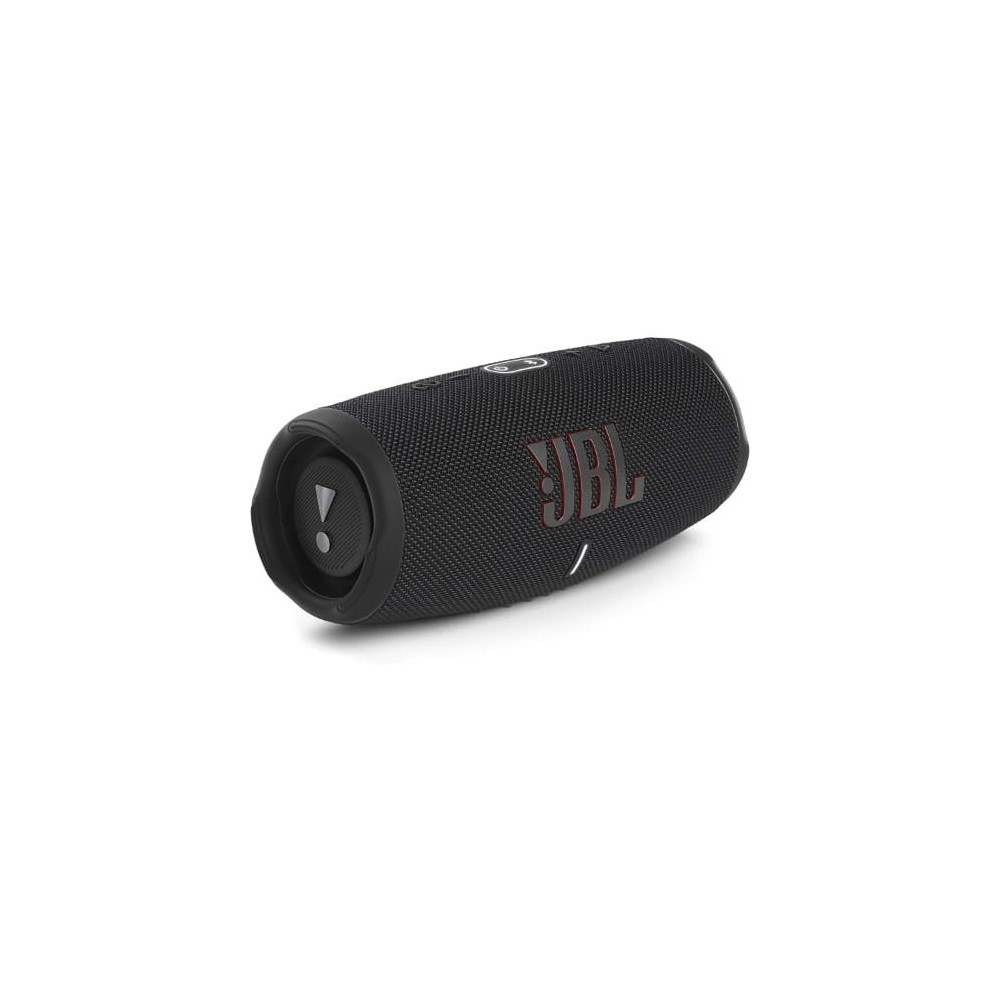All products featured are independently chosen by us. However, SoundGuys may receive a commission on orders placed through its retail links. See our ethics statement.
JBL Charge 5 vs JBL Pulse 5
August 16, 2024



The JBL Charge 5 remains one of the most popular Bluetooth speakers you can buy and with good reason. It’s durable, has decent sound, and has excellent battery life. What else do you need to enjoy some quality tunes with a few friends? Well, maybe a dynamic light show that pulses along to your music. So, enter the JBL Pulse 5 and all its mesmerizing glory. But does its 360-degree light show justify the premium price tag? In this JBL Charge 5 vs. JBL Pulse 5 article, I’ll outline the differences between these capable speakers to help you decide which one to buy.
Editor’s note: this article was published on August 16th, 2024, and is the first version of the article. Updates will follow as the market changes.
What’s it like to use the JBL Charge 5 compared to the JBL Pulse 5?
While the JBL Charge 5 and JBL Pulse 5 share several features, it’s no secret from their appearance that they’re very different speakers. One offers a pulsing, dynamic 360-degree light show to accompany your tunes; one does not. However, both of these JBL units feature 40W of mono playback, a companion app with a 3-band customizable EQ, and an IP67 protection rating, meaning both speakers are dustproof and waterproof.
The Charge 5 is an ideal portable Bluetooth speaker. You can toss it in your backpack without a care, and it won’t be the end of the world if it accidentally tumbles out of the back of your car or a friend spills a drink on it, for that matter. While the Pulse 5 is also durable, you risk scratching or damaging its clear acrylic finish if you accidentally drop it, potentially compromising the quality of its light show. It already picks up fingerprints and smudges with ease.
Another factor to take into consideration is weight. The Pulse 5 weighs in at 1.47kg. That’s roughly a Charge 5 and a half, weighing only 980g. Not to say the Pulse 5 isn’t portable; its cylinder shape is fairly travel-friendly, but if you’re looking to travel light, the Charge 5 will help keep the weight of your backpack down. That said, if you’re mainly listening around the house or having a few friends over to hang on the back deck, the light show provided by the Pulse 5 is genuinely enjoyable and can really add to the ambiance.
How do you control the JBL Charge 5 and JBL Pulse 5?
You control the Charge 5 via raised tactile controls on the top of the speaker’s enclosure. In addition to playback controls, this is also where you’ll find your power, Bluetooth, and Party Boost buttons.
The Pulse 5 does not contain any physical playback controls, so you’ll have to use your device to control your music. It does, however, have a vertical control strip on the back of the unit, consisting of your power, Bluetooth, Party Boost, and light show button. The light show button will cycle through various color combinations, which you can customize further via the JBL Portable app.
Should you use the apps of either JBL Charge 5 or JBL Pulse 5?
I recommend downloading and installing the JBL Portable app no matter which speaker you decide on. The Charge 5 has a 3-band EQ that allows you to personalize your sound. You can pair a second Charge 5 for stereo performance and access Party Boost mode, which lets you link up with additional JBL speakers, the Pulse 5 included, for playback from multiple speakers. It’s worth noting that you can only achieve stereo performance by pairing an identical model.
Regarding the Pulse 5, the JBL Portable app lets you personalize your speaker’s sound and light show. You can choose from various patterns and colorways, not to mention the same EQ, Party Boost, and stereo pairing options as the Charge 5. The “Ambient Sound” feature is also pretty cool, with decent-quality recordings. If you want to fall asleep to a crackling campfire and some ocean waves, or both simultaneously, you can select a few different nature-inspired background sounds with a shut-off timer.
How do the JBL Charge 5 and JBL Pulse 5 connect?
The Charge 5 connects to your device via Bluetooth 5.1, but the Pulse 5 connects to your device via Bluetooth 5.3. This isn’t much of a concern when comparing the two because both units still offer multipoint connection, allowing you to connect to two different devices if you and a friend want to take turns cueing up your tunes.
The Charge 5 and Pulse 5 charge via USB-C and are SBC only. Neither speaker offers higher bit-rate listening options, which is not uncommon for portable Bluetooth speakers; they’re not exactly meant for critical listening.
Is battery life better on the JBL Charge 5 or JBL Pulse 5?
The Charge 5 wins this round. Offering 20 hours of playback off a single charge, the Pulse 5 only provides 12 hours. Of course, battery life is always affected by factors like how loud you crank your speaker, your EQ settings, and, in the case of the Pulse 5, how intense and bright your light show is.
Anything that makes your speaker work harder will start reducing playback time. Using the Pulse 5 as my daily driver while working from home with its light show on full blast, I found myself plugging it in almost once a day to keep the battery topped up.
Does the JBL Charge 5 sound better than the JBL Pulse 5?
Returning to their specs, both of these 40W speakers offer mono playback. The Charge 5 has a forward-firing driver, tweeter, and dual passive radiators. The Pulse 5 contains an upward-firing driver, tweeter, and a single, downward-firing passive radiator on its underside. Either speaker is capable of keeping a small—to medium-sized gathering going.
Their different layouts provide a different listening experience when compared directly. Listening to “Bad Guy” by Billie Eilish in its stock form, the Pulse 5 proves a better bass response with its passive radiator firing directly onto the glass top of my desk. However, with the treble frequencies being projected upwards instead of at you like the forward-facing Charge 5, you don’t quite hear the same production details in the breathiness of her vocal tracks. That said, this vertical design does help with room-filling power. If you place your Pulse 5 in the center of your gathering, your guests will enjoy a consistent listening experience no matter how they face your speaker.
The Charge 5’s forward-firing design works better in the corner of a room, facing the party directly. The horizontal layout also delivers a broader-sounding performance, considering its mono-playback. The details in her vocals have returned. With a quick visit to the JBL Portable app, there is room to tweak. Bringing up the Bass slider quickly brought its low-end response closer to the sound of the Pulse 5. Fortunately, thanks to the app, you can make these EQ adjustments to personalize the sound of either speaker.
You’re most likely buying the Pulse 5 for its light show. Luckily, like the Charge 5, it will also provide you with that familiar bass-heavy JBL sound, and you can always use the EQ to get a little bit more out of either speaker.
Should you get the JBL Charge 5 or JBL Pulse 5?
If portability, durability, and battery life are high on your priority list, go ahead and snag the Charge 5. It’s tried and true, with good sound. You don’t have to baby this speaker, and the USB-A courtesy outlet is a nice touch for charging devices on the go if needed.
While the Pulse 5 also provides decent sound, its hefty price reflects the fact that its light show is its main selling point. Combined with the added weight, the Pulse 5 makes for a better backyard and around-the-house speaker. I genuinely enjoy the light show vibes while using the Pulse 5 in my home office, but I can’t deny that I have to keep a USB-C cable handy to charge it daily.
What should you get instead of the JBL Charge 5 and JBL Pulse 5?
If you like the idea of a light show that pulses along with your favorite tunes, take a look at the Anker Soundcore Boom 2. ($249.99 at Amazon) This party speaker has built-in dual LED lights on its passive radiators and 2.1 stereo sound, not to mention double the Charge 5 and Pulse 5 wattage. The Boom 2 offers 80W of output with BassUP mode engaged. Like the Charge 5, it has an IPX7 rating and features a USB-A for charging your device in the field.
Frequently asked questions
Yes. Both units are IP67-rated, meaning they can survive being submerged in a meter of water for up to 30 minutes.
JBL states that both the Charge 5 and Pulse 5 require 4 hours to charge fully.
No. Neither speaker features an AUX input. Bluetooth is your only connection option.
Yes, both speakers offer PartyBoost and can connect to other JBL speakers via the JBL Portable app.
Sure. Either speaker can be used while it charges via USB-C.
With its USB-A courtesy outlet, the Charge 5 can charge your phone. The Pulse 5 does not feature a courtesy outlet, so you cannot.
Thank you for being part of our community. Read our Comment Policy before posting.